I really enjoy the process of editing a photo. Each one is different. And it can be a lot of fun playing with ideas, colors, highlighting this area, downplaying another. A single photo really does have a lot of possibilities depending on what you do with it. But I’ll often make a photograph knowing in advance the edits I’ll need to make to “develop” it. Ready in 3 minutes was such a photo.
I shot this at our local county fair at around sunset. As we were leaving, a scene presented itself that I had to shoot and I only had a few seconds to get it. Unfortunately, there were a couple of problems. Although it was sunset, all of the beautiful golden light was being blocked by a building behind us. And I was dealing with a large dynamic range because I wanted to capture the brightly lit marquee and the dark interior of the photo booth. Here is the original shot:
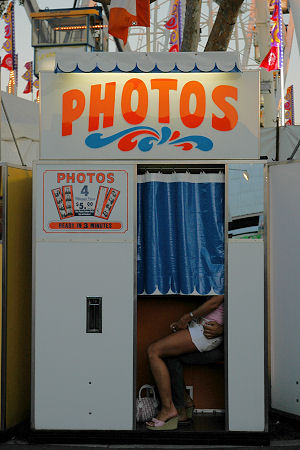
Original. 1/200s @ f/4.5
You’ll notice right away that it’s a little underexposed. I had already set the camera to shutter priority and 1/200s to capture the lights of the fair and the colors of the sunset. I probably should have switched to aperture priority to let the camera slow down the shutter speed but—well, I forgot. Fortunately, it’s not too bad. The exposure I had chosen did the job I had intended it to do and captured the marquee and lights in the background well. So, the first step during editing was to increase the overall exposure a little. I like to start with the Levels tool which lets you set the white and black points (the brightest and darkest pixels in the photo). Doing that stretches out the usable part of the histogram. In this case, I moved the white point down adding about a full stop of exposure. I also increased the black level a tiny bit which bumped up the contrast:
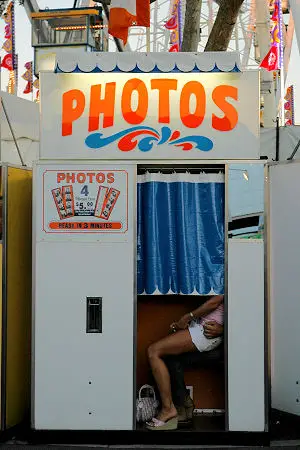
Ready in 3 minutes step 2: levels
That’s better but the exposure still isn’t where I want it. I really want the booth to be white. I don’t remember if it actually was white or not (it was probably fairly dirty) but I want it to be white. Next step is the Curves tool. Adjustment curves are something you should get to know. They’re an extremely powerful way to adjust not only the brightness but also the contrast and even the color of a photo. In this case, I only wanted to increase the brightness of the bright areas of the image and leave the dark areas alone. This accomplishes my goal of whitening the photo booth and increases the contrast again:
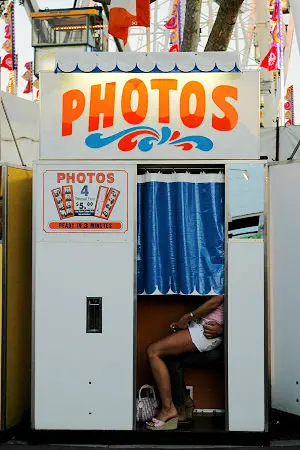
Ready in 3 minutes step 3: curves
Next up, a very slight color saturation increase. The effect is very subtle but I like it better than the previous step. You have to be careful with increasing saturation because you can easily lose detail in over-saturated areas, especially bright reds.
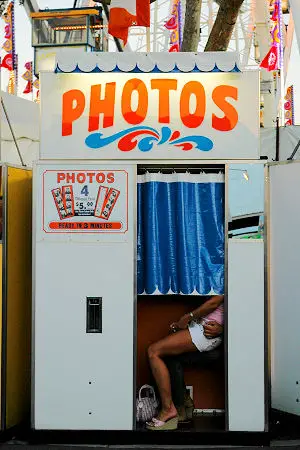
Ready in 3 minutes step 4: saturation
Finally, we get to the real subject of this photo and the reason I shot it. When I saw these two step into the booth I knew it was going to be a good shot. These two people in the photo booth, their hands, the surroundings—it all told an interesting story. I’m only sorry I wasn’t ready a little faster—they went through a number of gyrations to get comfortable in the small booth.
When I shot this, I knew I’d have to adjust the area under the curtain. I was dealing with a bright marquee and lights and the relative darkness of the booth interior (and as I found out later a little underexposure). I knew when I shot it that I would want to enhance their legs and hands later. Another curves adjustment to the rescue! But, in this case, I only wanted the adjustment to affect the rectangle directly beneath the curtain. So, I made the adjustment and then created a mask based on the rectangular selection so that the adjustment only affected that part of the photo:
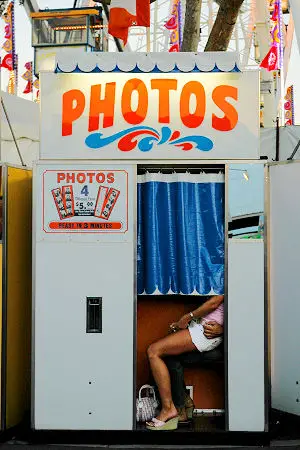
Ready in 3 minutes step 5: more curves
I’m pretty happy with the final result. It’s very much like my memory of the moment. And despite the dramatic change from the original, each of the adjustments was actually fairly subtle. It shows how a few small adjustments can make a photo really stand out. I hope it also shows that you have to start with a photo that’s already pretty close to your final vision. You’re probably not going to succeed if you have to make numerous, huge adjustments in an attempt to “salvage” a photo. As the saying goes: garbage in, garbage out.








